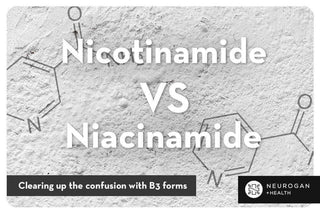Vitamin B3, also called niacin or nicotinic acid (if you want to get scientific), comes in different forms.
Nicotinamide and niacinamide are one form of niacin as they're chemically identical but have slightly different names and uses. They’re just called different names depending on how they’re used. To make things even more confusing, other forms of vitamin B3, like nicotinic acid and nicotinamide riboside (NR), have their own special functions.
How Are Nicotinamide and Niacinamide The Same?
Nicotinamide and niacinamide are forms of vitamin B3, sharing the same chemical structure and benefits. The body needs B3 for cellular metabolism, energy production, and maintaining skin health.

How Are Nicotinamide and Niacinamide Different?
The main difference is in their use as supplements, where nicotinamide is often marketed as a non-flushing form of niacin, meaning it does not cause the skin-flushing side effect associated with niacin, and niacinamide is usually used in skincare.
The main takeaway is that nicotinamide and niacinamide are the same substance, and these names are often used interchangeably.
|
Similarities |
Differences |
|
Both are amide forms of vitamin B3. |
Nicotinamide is the name usually used in dietary supplements for overall cellular health marketed as non-flushing niacin. |
|
They have the same chemical formula. |
Niacinamide is the name used in skincare products to help improve the look of your skin and support its protective barrier. |
|
Both can help your skin look healthier by improving its elasticity and tone. |
Nicotinamide is the more scientific term, and Niacinamide is a more commonly used term in the skincare industry. |
|
They can support your body’s cells and are important for energy production. |
|
|
Both forms are found in various foods, including meat, fish, milk, eggs, green vegetables, and cereals. |
|
|
Nicotinamide and niacinamide won’t make your skin feel hot, red, or itchy when you take them as a supplement. |
|
|
The amount of nicotinamide or niacinamide you should have each day (according to the recommended dietary allowance (RDA)) is about 14-18 mg, depending on your age, if you're male or female, or if you're pregnant. |
Is Niacinamide the Same As Niacin?
No, niacinamide is not the same as niacin, even though they are both forms of vitamin B3 and are closely related. Niacin is sometimes called the "original vitamin B3."
-
Niacin (nicotinic acid) is a specific form of vitamin B3 that helps the body produce energy and supports healthy metabolism. The downside of taking niacin supplements is that high doses can cause a "niacin flush," which makes it feel like your skin is warm, itchy, and red.
-
Niacinamide is another form of vitamin B3 that doesn’t cause flushing. It’s created when the body converts niacin or gets it directly from food or supplements. Niacinamide can be taken internally, although it’s most commonly associated with topical skincare products. If you’re looking at supplements, you’re more likely to see nicotinamide listed on the label, even though the two terms are interchangeable in a technical sense.
Nicotinmiade Riboside vs. Niacinamide
Another member of the vitamin B3 family is nicotinamide riboside (NR). This form of vitamin B3 is mainly found in supplements and is used to help increase NAD (nicotinamide adenine dinucleotide) levels. NAD is super important because it helps all your cells turn food into energy. As we get older, our NAD levels naturally drop, which is one reason aging affects how our bodies work.

Like nicotinamide and niacinamide, NR is a type of vitamin B3, and it also gets converted into NAD in the body to support energy in your cells. What makes NR special is that its structure allows it to boost NAD levels more efficiently than nicotinamide.
Meanwhile, niacinamide is better known for its role in skincare, helping to improve the look and feel of your skin. So, while both NR and niacinamide come from the same vitamin, they're used for very different wellness goals — NR for cellular energy and aging support and niacinamide for healthier-looking skin.
NAD vs. Niacinamide
NAD is a coenzyme in every living cell, essential for cellular energy production and metabolic processes. Niacinamide plays a role in NAD production, as it is a precursor to this vital molecule.

When taken internally or applied, niacinamide or nicotinamide can be converted into NAD through metabolic pathways, but it's not as direct as other forms of B3.
Products like nicotinamide riboside and nicotinamide mononucleotide (NMN) are designed to increase NAD levels in the body more directly, providing a more targeted approach to boosting cellular energy.
Which B3 is Used for Healthy Cholesterol Management?
The version of vitamin B3 used for cholesterol management is niacin or nicotinic acid. Niacin has been studied for its ability to help improve cholesterol levels by influencing the way your liver produces cholesterol and fats in animals [1].
However, high doses of niacin can cause side effects like skin flushing, itching, or liver issues, so it’s typically used under a doctor’s supervision for managing cholesterol. Niacinamide and nicotinamide riboside (NR) do not have the same cholesterol-lowering effects as niacin.
Which form of B3 is Used for Skin Barrier Health?
Niacinamide is often formulated in topical skincare products like creams, serums, and gels to help improve skin texture and tone. Niacinamide can balance how much oil your skin produces, which helps prevent clogged pores and strengthens the skin’s natural barrier, making it better at holding moisture and protecting against irritants.

Another benefit of adding niacinamide to your skincare routine is to fade dark spots left behind by acne or scars. When choosing a product, look for 2-10% niacinamide concentrations for effective skincare benefits without irritation.
Which form of B3 Helps With Healthy Aging?
There's some debate as to which B3 is the best for longevity research, but the main contenders are nicotinamide riboside (NR) and nicotinamide mononucleotide (NMN).
The debate between Nicotinamide Riboside (NR) and Nicotinamide Mononucleotide (NMN) for healthy aging depends on how the body processes these compounds and the individual's specific goals of supplementation.
Both are effective at boosting NAD (nicotinamide adenine dinucleotide) levels, but they have differences that may make one a better fit depending on individual needs, and it's more widely available in various supplement forms.
NMN is one step closer to NAD production as it doesn't need to convert into NMN first as NR does. Some research suggests that specialized transporters can directly absorb NMN into the cells, and much research has linked its potential to support cellular health, aging, and DNA repair [2].
If you decide between the two, it may come down to availability, personal preference, and how your body responds to these compounds.
Nicotinamide vs. Niacinamide Are Vitamin B3 Forms
Nicotinamide and niacinamide are two different names for the same vitamin B3, but they’re used differently.
You'll see nicotinamide in supplements if you want to help your body’s cells stay healthy and full of energy. If you’re trying to make your skin look smoother and fix uneven skin tone, you’ll see niacinamide listed as an active ingredient in skincare products like creams or serums.
Resources:
-
Shah, T. Z., Ali, A. B., Jafri, S. A., & Qazi, M. H. (2013). Effect of Nicotinic Acid (Vitamin B3 or Niacin) on the lipid profile of diabetic and non–diabetic rats. Pakistan journal of medical sciences, 29(5), 1259.
-
Nadeeshani, H., Li, J., Ying, T., Zhang, B., & Lu, J. (2022). Nicotinamide mononucleotide (NMN) as an anti-aging health product–promises and safety concerns. Journal of advanced research, 37, 267-278.




